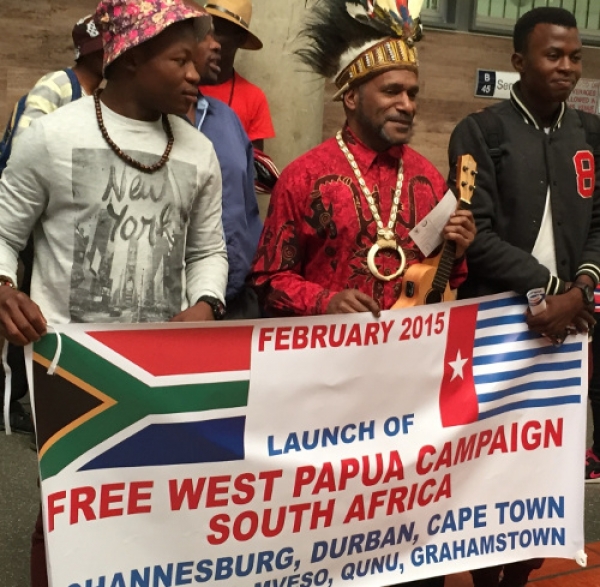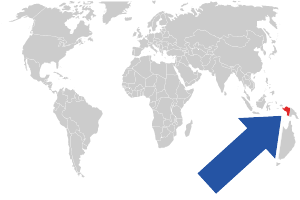West Papua’s “Cry for help, Cry for Freedom”

On 17 February Equal Education hosted a talk by Benny Wenda of the Free West Papua Campaign at the Wits School of Education. He is in South Africa to spread awareness about the West Papuan fight against Indonesian colonialism and gross human rights abuses of the West Papuan people. He said he was also here to “learn how [South African] leaders fought against apartheid, for justice and against [racial] discrimination.”
Doron Isaacs, deputy general secretary of Equal Education opened the proceedings - which were attended my Wits students, members of the PAC and Equal Education staff and members – remarking that EE has a tradition of supporting campaigns, irrespective of locality, which fight oppression under the banner of social justice. He stated that national borders, which are largely constructs of human history, although separating us geographically do not separate us as human beings. He hoped that ‘in a small way we can assist in the struggle’ to free West Papua from the internecine oppression of Indonesia.
Wenda is a political exile residing in the UK. He escaped prison, and the sustained threat made on his life by the oppressive forces of the occupying Indonesian militia in his native West Papua (three attempts were made on his life while in prison by Indonesian military men). He eventually broke through a ventilation shaft and jumped the wall of the prison in which he was held. After a two week journey on foot through the dense West Papuan forests, he acquired a fake passport and escaped to the UK where he helped form the Free West Papua Campaign and International Parliamentarians for West Papua (IPWP)
He is a founder and spokesperson for the Free West Papua Campaign, founded in 2004, which strives ‘to give the people of West Papua the freedom to choose their own destiny through a fair and transparent referendum – a freedom they have always been denied’. According to Wenda there is a total ban on media coverage of West Papuan life: ‘On every corner there is a military man holding a gun’, preventing local people from documenting, and disseminating to the rest of the world, the atrocities committed on their friends and family.
Wenda, the chief of the largest West Papuan tribe – the Lanu tribe – said that he was honoured to be in South Africa among young people who have political freedom, freedom from discrimination based on race, and access to education – fundamental rights which the children of West Papua are denied. ‘We never learned the map of the world, only the map of West Papua up to Indonesia….I never learned about my mountains, my rivers….they [Indonesian authorities] the names of everything’, he said. West Papuan culture and identity was brutally suppressed and wrested away from its people.
He began his talk with a song, called the ‘cry song’ which is about West Papuan ‘land, culture, identity and their way of life’. The song has been banned in West Papua where raising the national flag, ‘morning star’, carries with it a 15 year jail sentence. Regaled in traditional attire of the Lanu tribe he ended the final notes of the song for freedom by saying I am ‘fighting for who I am and who we are….This is who I am’.
According to Wenda, West Papuans are regularly abused (he told the story of a 50 year old man who had his genitals burnt by the Indonesian militia), murdered (his uncle was buried alive) and raped by the Indonesian colonial forces. They are treated like animals because they are black, he said. He estimates that close to 500,000 West Papuans have been murdered by the Indonesian military since the beginning of their occupation. Few people around the world know about this “secret genocide”.
He recounted a personal story of dehumanisation in which, while a student new to high school, a girl spat in his face on two consecutive days because “[his] skin was black”. He eventually went to university and studied politics “to fight back”.
West Papua, situated in the Western half of the Island of New Guinea, was a former colony of the Dutch East Indies but also saw waves of British and German Colonial rule until it was annexed by a newly independent Indonesia in 1963 under the UN sanctioned New York agreement.
Where is West Papua?

This map from the Free West Papua website shows where this island is located.
According to Wenda, under the increasing threat of Indonesia siding with the Soviet Union during Cold War, the US and UN acceded to Indonesia’s desire to take West Papua into its control. Indonesia effectively told the US and UN, “if you don’t give West Papua to us we will side with the Soviets in the Cold War.”
The UN then supervised a referendum in West Papua in 1969, which Indonesia calls the “Act of Free Choice”, and West Papuans “The Act of No Choice”. According to Wenda, West Papuans were coerced into voting for Indonesian rule under the barrel of the gun, while the UN stood by and eventually approved the legitimacy of the referendum. He also spoke of an agreement between the US and Indonesia to share the spoils of the mineral rich West Papuan territory.
After students and Equal Education members asked questions which ranged over how South Africans could contribute to the West Papuan cause and the state of liberation movements within West Papua, Wenda ended the hour by asking all present to “please remember my people’s cry for help, our cry for freedom.”
To follow The Free West Papua campaign’s tour through South Africa see their Facebook and Twitter (@FreeWestPapua) pages.
Maserow works for Equal Education. GroundUp is not in a position to verify the facts reported in this article, and no inference should be made on whether the views expressed here reflect the editorial position of GroundUp.

This article is licensed under a Creative Commons Attribution-NoDerivatives 4.0 International License.


